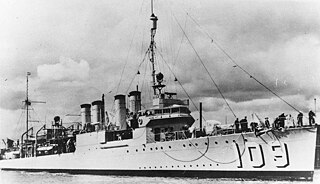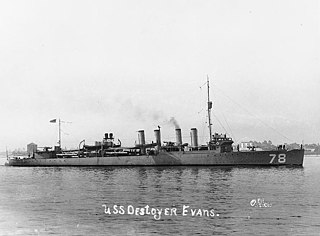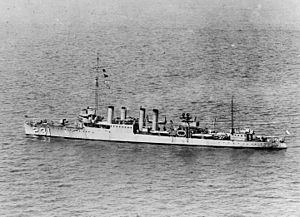
USS Crane (DD-109) was a Wickes-class destroyer in the United States Navy. She is named for naval officer William M. Crane.

The first USS Philip (DD–76) was a Wickes-class destroyer in the United States Navy during World War I, later transferred to the Royal Navy as HMS Lancaster. She was named for John Woodward Philip.

The first USS Evans (DD–78) was a Wickes-class destroyer in the United States Navy during World War I, later transferred to the Royal Navy as HMS Mansfield.

USS Patoka (AO–9/AV–6/AG–125) was a replenishment oiler made famous as a tender for the airships Shenandoah (ZR-1), Los Angeles (ZR-3) and Akron (ZRS-4). It was also notable in that its height figured prominently in the design of the Rainbow Bridge in Texas.

USS Dent (DD–116) was a Wickes-class destroyer in the United States Navy during the World War I and later served as APD-9 in World War II. She was named for Captain John H. Dent.

USS Elliot (DD-146) was a Wickes-class destroyer in the United States Navy during World War II, first reclassified as DMS-4, and later reclassified as AG-104.

USS Yorktown was lead ship of her class of steel-hulled, twin-screw gunboats in the United States Navy in the late 19th and early 20th centuries. She was the second U.S. Navy ship named in honor of the American Revolutionary War's Battle of Yorktown.

USS McGinty (DE-365) was a John C. Butler-class destroyer escort of the United States Navy.

USS Wright (AZ-1/AV-1) was a one-of-a-kind auxiliary ship in the United States Navy, named for aviation pioneer Orville Wright. Originally built as a kite balloon tender, she was converted into a seaplane tender after kite balloons were no longer used.

USS MacLeish (DD-220/AG-87) was a Clemson-class destroyer in the United States Navy during World War II. She was named for Lieutenant Kenneth MacLeish.

USS Fox (DD-234/AG-85) was a Clemson-class destroyer in the United States Navy during World War II. She was the fourth ship named for Gustavus Vasa Fox, Assistant Secretary of the Navy during the Civil War.

USS Kane (DD-235/APD-18) was a Clemson-class destroyer in the United States Navy during World War II. She was the first ship named for Elisha Kent Kane.

USS Williamson (DD-244/AVP-15/AVD-2/APD-27) was a Clemson-class destroyer in the United States Navy during World War II. She was named for Commander William Price Williamson.

USS Gillis (DD-260/AVD-12) was a Clemson-class destroyer in the United States Navy. She was named for Commodore John P. Gillis and Rear Admiral James Henry Gillis.

USS William Jones (DD-308), a Clemson-class destroyer in the United States Navy, named for William Jones.

USS Southerland (DD-743), a Gearing-class destroyer, was the only ship of the United States Navy to be named for William Henry Hudson Southerland, an admiral.

USS Gantner (DE-60/APD-42), a Buckley-class destroyer escort of the United States Navy, was named in honor of Boatswain's Mate Samuel Merritt Gantner (1919-1941), who was killed in action during the Japanese attack on the Hawaiian Islands.

USS Gilmore (DE-18) was an Evarts-class short-hull destroyer escort in the service of the United States Navy.

USS Kingfisher (AM-25/AT-135/ATO-135) was an Lapwing-class minesweeper acquired by the U.S. Navy for the dangerous task of removing mines from minefields laid in the water to prevent ships from passing.

USS Waxbill (MHC-50/AMCU-50/AMS-39/YMS-479/PCS-1456) was a YMS-1-class minesweeper of the YMS-446 subclass acquired by the U.S. Navy for the task of removing mines placed in the water to prevent ships from passing.




















